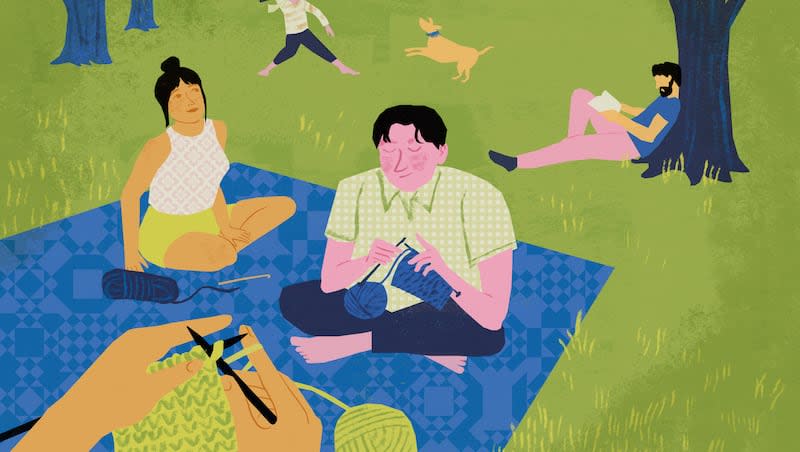Can public parks save us from loneliness?

When I had my first child, much of my life revolved around a 6-acre park about a 10-minute walk from my house in Somerville, Massachusetts. Lincoln Park had a playground and spacious green space adjacent to a public school — perfect for unleashing the energy of a toddler.
Our routine could partly be explained by the facts of our living conditions. Somerville, right outside of Boston, is the most densely populated city in New England, and it’s been gentrifying for the past two decades. Most families in my neighborhood live in condos and don’t have a lush green backyard to enable free-range frolicking for their children; my own backyard consists of a concrete patio and a sliver of grass. So instead, we flock to public parks.
But Lincoln Park turned out to be more than a playground for my children to run wild. While children played, parents had nothing else to do, so we talked and we got to know each other. The demographic at my park was always eclectic: folks from different cities and countries, with different religious backgrounds and family structures; many had come to this area to study at Boston universities.
But at the park, these differences didn’t seem to matter; in fact, they were conversation starters that fostered a point of connection. One urban designer has called places like Lincoln Park “sticky” — they “invite people to stop, stay, and connect.” That was my experience. Some of my most unexpected friendships sprouted at the park: a home-schooling therapist, a chocolatier, a Danish sound bath practitioner. The setting lent itself to some of my most insightful and intimate conversations. In the days of sleepless delirium that all new parents know, these moments of connection kept me sane.
Research backs up what I had experienced at Lincoln Park. Recreational spaces and parks can foster a sense of belonging among community members. Green spaces in particular can increase our mental well-being and lower rates of depression, according to a 2021 study. “Nature connectedness was also positively associated with positive well-being and negatively associated with mental distress and was, along with green space visits, associated with a lower likelihood of using medication for depression,” the study’s authors said.
Public parks are part of what’s known as social infrastructure, which can include libraries, school playgrounds, community gardens and swimming pools, according to Eric Klinenberg, a sociologist at New York University who wrote “Palaces for the People: How Social Infrastructure Can Help Fight Inequality, Polarization, and the Decline of Civic Life.”
“It’s long been understood that social cohesion develops through repeated human interaction and joint participation in shared projects, not merely from a principled commitment to abstract values and beliefs,” Klinenberg wrote. Social infrastructure, he wrote, is especially beneficial for children, the elderly and those who are limited to move beyond the places where they live. It’s the communal gathering places that might also foster a sense of civic responsibility. “Democracy must begin at home, and its home is the neighborly community,” Klinenberg wrote.
These communal gathering places, also called “third places,” offer a solution for loneliness in our fragmented digital age. “Studies have shown that just having a diversity of folks in your life … more informal and infrequent and unplanned, can be really protective for health and well-being,” Jessica Finlay, an assistant professor in the Institute of Behavioral Science and the department of geography at the University of Colorado, Boulder, told Vox. “Classically, third places were sites where you could build up these bridging ties.”
Even “weak social ties,” according to a study that Vox cited, such as a brief connection with an acquaintance, can increase feelings of belonging, Vox reported. Yet many Americans don’t view accessibility to a third place as a priority. According to a 2023 Pew Research Center survey cited by Vox, more than half of Americans say they would opt for a larger house, even if that means they are farther away from schools, stores and restaurants.
During the pandemic, when we could only gather together outside, I felt the value of Lincoln Park acutely. It offered a glimpse of normalcy, the life we all hoped we’d eventually get back. It was a place for social-distanced and masked picnickers, an en-plein-air gym for exercise groups and, of course, an outlet for cooped-up children. In the aftermath of the pandemic, housing prices skyrocketed, and many of my friends moved away from the city. Being in a place like Somerville increasingly felt like a great privilege even despite the relative inconveniences.
These days, with the long-awaited arrival of spring, on any given Saturday, Lincoln Park may look something like this: Skaters, who look like grown men in teenage clothing, are performing tricks at the concrete skate park. Slightly to the side, toddlers are at work digging in a sandbox and climbing at a jungle gym. A few feet away is a larger play structure for older kids. Some adults are swinging in the hammocks, reading. Cyclists are circling around the soccer field. There may be a birthday party at the picnic tables and a baseball team practicing. On Sunday afternoons, a local marching band holds practices at the park, and sounds of trumpets echo through the neighborhood. Even if you don’t know anyone there, you can’t help but feel part of a place that’s so vibrant and alive.
It’s an idyllic scene that I often conjure up when I try to explain to my suburban-dweller friend why, as a family of five, we haven’t traded our tight quarters for a more spacious, more convenient lifestyle in the suburbs. The proximity to third spaces like a doughnut shop, our public library and Lincoln Park make the inconveniences less stark. I’ve also had to shift my definition of home — it’s not just my apartment, with one bathroom and a concrete patio with a sliver of grass, but an entire neighborhood.